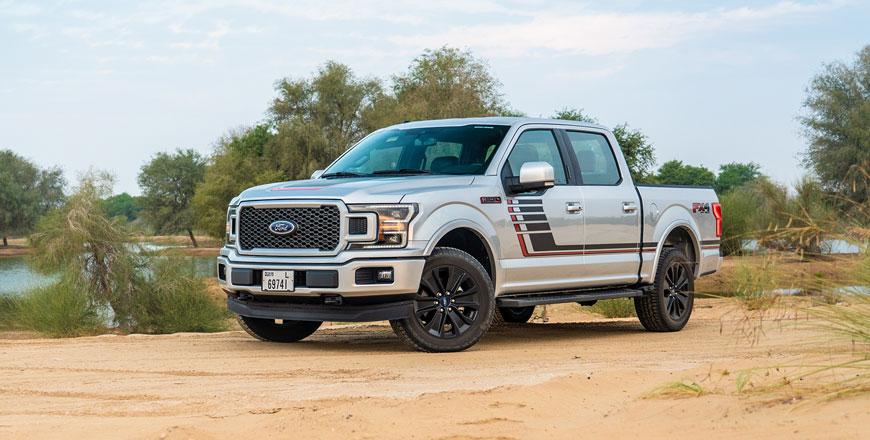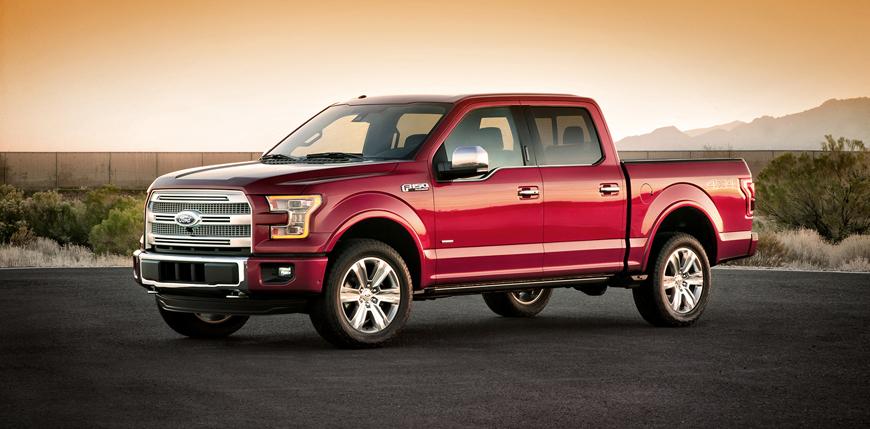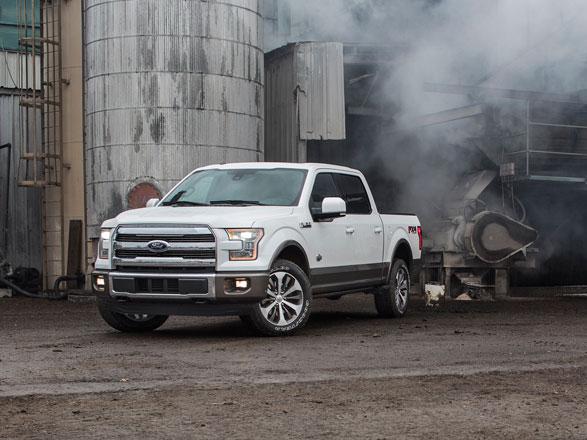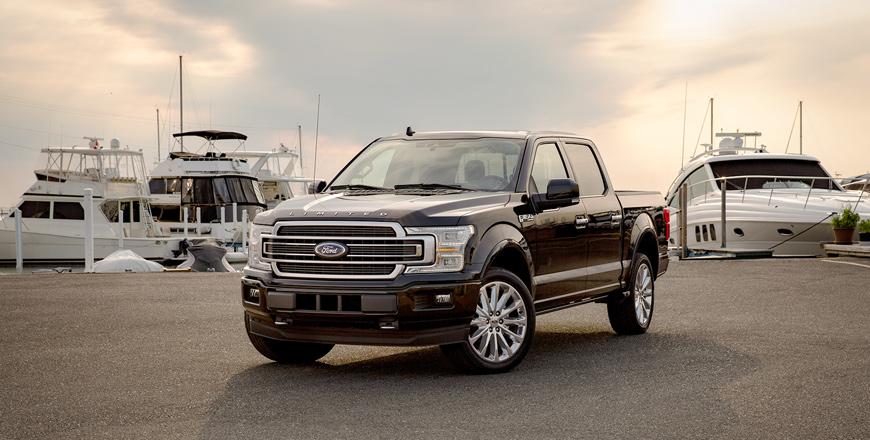You are here
Ford F150 Lariat Sport Special Edition: A faithful foul-weather friend
By Ghaith Madadha - Jun 01,2020 - Last updated at Jun 01,2020

Photos courtesy of Ford
America’s best selling truck for over four decades and a staple work, play and family vehicle in North America and the Middle East; to say that the Ford F150 is familiar is an understatement. A rugged and practical everyman truck brimming with technology, capability and creature comforts, the F150’s many merits — and large truck vices for certain markets — are well established. Inspiring admiration during many previous test drives, it has never been as convincing as earlier this year, during several days dominated by torrential rains and flooded roads.
Delivered on a sunny first day gleaming from a fresh wash and in an almost matte grey silver finish that reminded one of its unique lightweight military grade aluminium body, the F150 also never looked as good as it did in Lariat Sport specification with Special Edition appearance package; bar of course the extra special skunksworks Raptor variant. Perfectly proportioned with its four-door Supercrew body, near equal height-to-width ratio and with just the right bulging to its wheel-arches to visually reduce the vertical distance to its bonnet, this F150 has distinctly more dramatic presence than usual.
Dramatic daily driver
With squared off features, sharp straight cut lines, twin-dome bonnet, vast upright grille and its appealing aesthetic proportions, the F150 has an unmistakably assertive presence that is full of tension and restraint, unlike some trucks’ overstated, almost caricature-like take on aggression. Both more dramatic and low key next to other F150 trim levels’ liberal use of chrome, the Special Edition body colour and black accents lend a more dramatic appeal. Black alloys and running boards, and its body colour grille outline, mesh and faux inlets bisecting its big headlights worked particularly well at bringing out the F150’s almost sinister side.
Decked out with bonnet-top and side decals that lend a sportier aesthetic and reduce the F150’s visual heft, the Sport part of this Lariat’s designation is nonetheless only an appearance package. However sportier they might “feel”, the Special Edition “go-faster” graphics don’t make the F150 go any faster. That said, the Lariat’s Sport’s twin-turbo direct injection 3.5-litre V6 Ecoboost engine provides plenty of “fast” as is. Down-sized but more efficient next to the F150’s more traditional naturally-aspirated 5-litre V8 Coyote engine, the Ecoboost is the more effective “real world” daily drive engine.
Bountiful boost
Offered in two states of tune across the F150 range, the Lariat line receives the standard 3.5 Ecoboost, developing 375BHP at an easily accessible 5,000rpm and enormous 470lb/ft torque peaking at 3,500rpm, but with much of that available throughout a broad rev band. Spooling up swiftly from standstill and with a comparatively low in-class weight due to its aluminium body, the F150 Lariat Sport proved quick and eager throughout, pouncing from standstill to 100km/h in an estimated 6-seconds and overtaking with effortless versatility, whether when cruising or at higher speeds.
Eager unleashing its power, the F150’s climb to its top end peak is underwritten by a deep indefatigable reservoir of torque allowing for urgent response and confident cruising. Meanwhile, its slick, quick and smart shifting 10-speed automatic gearbox provides a broad range of closely spaced ratios to best utilise available output for performance and economy. Built to haul and tow heavy loads of up to 921kg and 5,760kg respectively, the F150 can be driven in regular high or low gear ratio four-wheel-drive for escalating levels of extreme loads, conditions, inclines and terrain.
Come rain or shine
However, when the storms came on the second day, the F150 coped perfectly well driving in its more economical rear-wheel-drive-mode in almost all circumstances, where plenty of traction and grip were available. Driven under such conditions — and the occasional dry spell — the F150 would turn into corners in a tidy manner with restrained body lean and reassuring front grip. Direct and well-weighted, the F150’s electric-assisted set-up well translates Ford’s usual knack for making sporty and connected steering feel for service in a truck.
Driven during a week of intensive test drives and intense weather, the Lariat Sport proved to be the most utilitarian, and took on the role of running reconnaissance. Comfortable, spacious and very well-equipped yet ruggedly luxurious, the tough, highly capable and trustworthy F150 served to scout “safe” routes before one dared venture out in more expensive, less rugged and “precious” vehicles. With it excellent 238mm ground clearance, four-wheel-drive and generous 25.5° approach 21° break-over and 26° departure angles, the F150 effortlessly traversed flooded streets where even some SUVs couldn’t go under prevailing conditions.
Rugged comfort
One of the best riding and handling in the large body-on-chassis and live axle rear suspension truck segment, the F150’s low in-class weight and near even weight distribution lend it comparatively keen handling, and it feels balanced through corners with good rear grip owing to its long wheelbase. Meanwhile, a brake-based torque vectoring system enhances cornering agility and stability. Stable at speed and more settled over lumps, bumps and imperfections, the F150 feels more vertically buttoned down than most rivals and is probably about as smooth and comfortable as trucks get in this segment.
Winner of the 2020 Middle East Car of the Year awards’ best Full-Size Truck category, the F150 is hugely spacious inside, especially with the absence of a sunroof, as driven in Lariat Sport spec, and comfortably seats five, with easy cabin access, voluminous storage spaces and advanced and extensive infotainment systems. Seating is comfortable, supportive and well adjustable, with dual tone upholstery in mid-range Lariat Sport trim. Front and side visibility is good, while big side mirrors and a 360° camera aid reversing and manoeuvrability. Standard and optional equipment meanwhile include a slew of advanced driver assistance safety systems.
TECHNICAL SPECIFICATIONS
- Engine: 3.5-litre, all-aluminium, twin-turbo, in-line V6-cylinders
- Bore x stroke: 92.5 x 86.7mm
- Compression ratio: 10.5:1
- Valve-train: 24-valve, DOHC, variable valve timing
- Gearbox: 10-speed automatic, four-wheel-drive, low ratio transfer case, optional locking rear differential
- Gear ratios: 1st 4.696; 2nd 2.985; 3rd 2.146; 4th 1.769; 5th 1.52; 6th 1.275; 7th 1.0; 8th 0.854; 9th 0.689; 10th 0.636; R 4.866
- Axle ratio options: 3.31:1 or 3.55:1
- Power, BHP (PS) [kW]: 375 (380) [280] @5,000rpm
- Specific power: 107.2BHP/litre
- Torque, lb/ft (Nm): 470 (637) @3,500rpm
- Specific torque: 182.2Nm/litre
- 0-100km/h: approximately 6-seconds (estimate)
- Top speed: 170km/h (estimated, electronically governed)
- Minimum fuel requirement: 91RON
- Length: 5,890mm
- Width: 2,030mm
- Height: 1,961mm
- Wheelbase: 3,683mm
- Track: 1,717mm
- Overhang, F/R; 960/1,247mm
- Ground clearance: 238mm
- Approach/break-over/departure angles: 25.5°/21°/26°
- Seating: 5
- Headroom, F/R: 1,036/1,026mm
- Legroom, F/R: 1,115/1,108mm
- Shoulder room, F/R: 1,694/1,674mm
- Hip room, F/R: 1,588/1,644mm
- Cargo bed height, length, width: 543, 1,705, 1,285-1,656mm
- Load floor height: 907mm
- Cargo box volume: 1,495-litres
- Fuel capacity: 98-litres
- Kerb weight: approximately 2,225kg (estimate)
- Payload: 921kg
- Towing maximum: 4,854-5,760kg (depending on axle ratio)
- Steering: Electric-assisted rack & pinion
- Turning circle: 15.57-metres
- Suspension, F/R: Double wishbones, coil springs/live axle, leaf springs
- Brakes, F/R: Ventilated discs, 350 x 34mm/drum, 336 x 24mm
- Brake calipers, F/R: Twin/single
- Tyres: 275/55R20
Related Articles
Much awaited and launched last, the 13th generation of America’s most iconic and best-selling pickup truck is the most advanced in its segme
Purveyor of America’s consistently best-selling model line, Ford took somewhat of a calculated — and ultimately successful — gamble with the
America’s best selling truck with a history going back to 1948, the Ford F150 has also been the most advanced pick-up in its segment since t



















